Scottish Greenhouse Gas Emissions 2013
This publication provides estimates of greenhouse gas emissions in Scotland for the years 1990 to 2013.
This document is part of a collection
Section D. Revisions Since the Last Inventory and Methodology
This section examines key revisions in estimated source emissions between the latest inventory (1990-2013) and the previous inventory (1990-2012) published in June 2014. In October 2014, the Scottish Government published a paper Scottish Greenhouse Gas Emissions 2012. Key Revisions Since 2008 which provides a breakdown of the key revisions to the data within the Scottish Greenhouse Gas Emissions Official Statistics publication over successive years from the 1990-2008 inventory. This section of the publication is intended to build on this revisions paper.
Compilation of the Greenhouse Gas Inventory
The greenhouse gas inventory covers a wide variety of all anthropogenic sources of greenhouse gas emissions and therefore a wide variety of emissions sources which require different approaches to their estimation. There are a large number of data sources used in its compilation, obtained from Government statistics, regulatory agencies, trade associations, individual companies, surveys and censuses. The methods used to compile the greenhouse gas inventory are consistent with international guidance on national inventory reporting from the Intergovernmental Panel on Climate Change.
Most emission estimates are compiled by combining activity data (such as fuel use) with a suitable emission factor (such as amount of CO2 emitted per unit of fuel used). Estimates of emissions from the industrial sector are often compiled based on plant-specific emissions data. Emissions from some sectors are based on more complicated models - such as the model used to estimate emissions from landfill, and the model used to estimate the carbon dynamics in soils when trees are planted. Much of the data on net emissions from agriculture and related land use, land use change and forestry emissions are based on modelled data for Scotland, which are consistent with, but not constrained to, the UK totals and thus are known as "bottom up" estimates.
Many of the remaining emissions sources within the inventory have been collated on a "top down" approach where estimates of emissions have been apportioned to Scotland using proportions of energy use in the Department of Energy and Climate Change (DECC) Publication "Digest of UK Energy Statistics (DUKES)". This approach is prompted by data availability on emissions being more limited at the sub-UK level.
Impact of Revisions
Charts D1 to D5 and Table D1 illustrate the impacts of revisions between the 1990-2012 and 1990-2013 inventories, both by sector and by greenhouse gas. This is followed by a discussion of the reasons for the key revisions.
Chart D1. Scottish Greenhouse Gas Emissions. Comparison of 1990-2012 and 1990-2013 Inventories. Values in MtCO2e
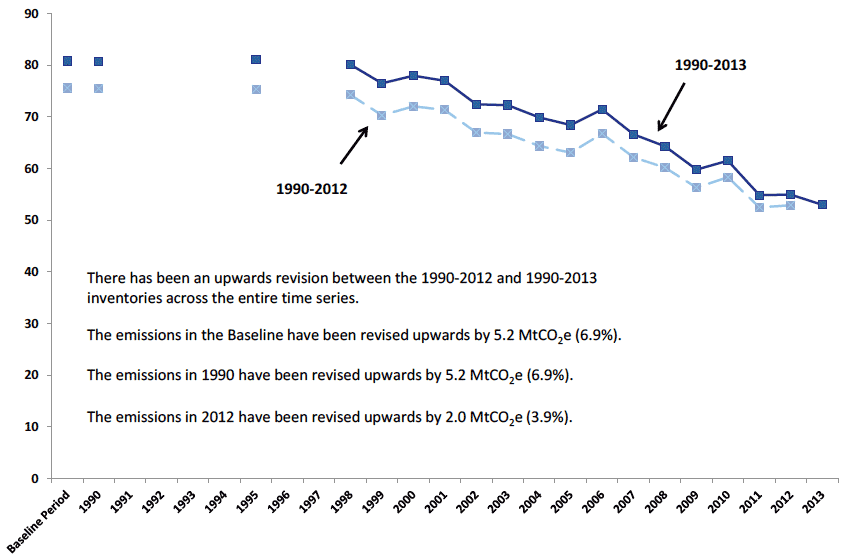
Chart D2 shows that the Waste Management sector contributed by far the greatest upwards revisions to emissions in the Baseline Period, at 3.2 MtCO2e (contributing to 60.9 per cent of the upward revision). Other sectors which saw considerable upwards revisions to emissions in the Baseline Period were Agriculture and Related Land Use (0.9 MtCO2e), Business and Industrial Processes (0.8 MtCO2e) and Energy Supply (0.3 MtCO2e). There was a small downward revision for Residential emissions.
Chart D2. Revisions to emissions in the Baseline Period, from the 1990-2012 inventory to the 1990-2013 inventory, by source sector. Values in MtCO2e, and percentage changes
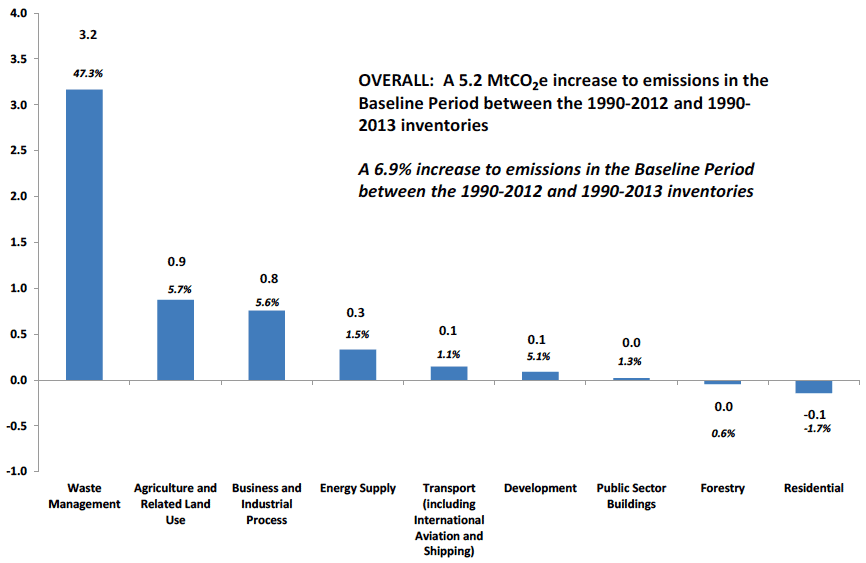
Chart D3 shows that the greatest upwards revisions in 2012 have occurred in the Agriculture and Related Land Use sector (1.4 MtCO2e; contributing to 67.2 per cent of revisions). The Waste Management emissions and Energy Supply emissions have both been revised upwards by 0.4 MtCO2e in 2012. Emissions in the Business and Industrial Process sector have been revised upwards by 0.3 MtCO2e.
Chart D3. Revisions to emissions in 2012, from the 1990-2012 inventory to the 1990-2013 inventory, by source sector. Values in MtCO2e, and percentage changes
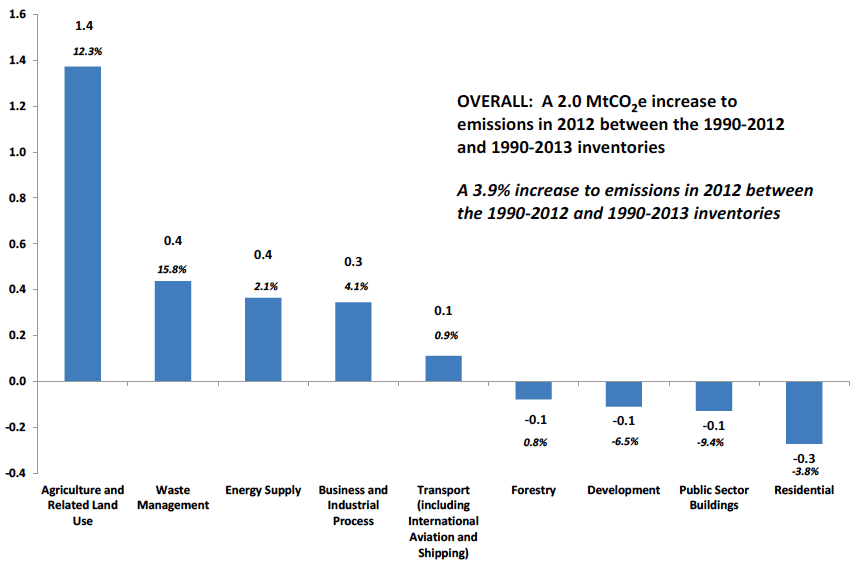
Chart D4 shows the impact of revisions to emissions in the Baseline Period for each greenhouse gas separately, with Chart D5 showing the impact of revisions in 2012. In both cases, methane emissions have seen the greatest upwards revisions, followed by carbon dioxide - with nitrous oxide emissions being revised downwards across the time series.
It is worth noting that the introduction of nitrogen trifluoride (NF3) has a negligible effect on the 1990-2013 greenhouse gas inventory. It was included for the first time in the 1990-2013 inventory.
Chart D4. Revisions to emissions in the Baseline Period, from the 1990-2012 inventory to the 1990-2013 inventory, by greenhouse gas. Values in MtCO2e, and percentage changes
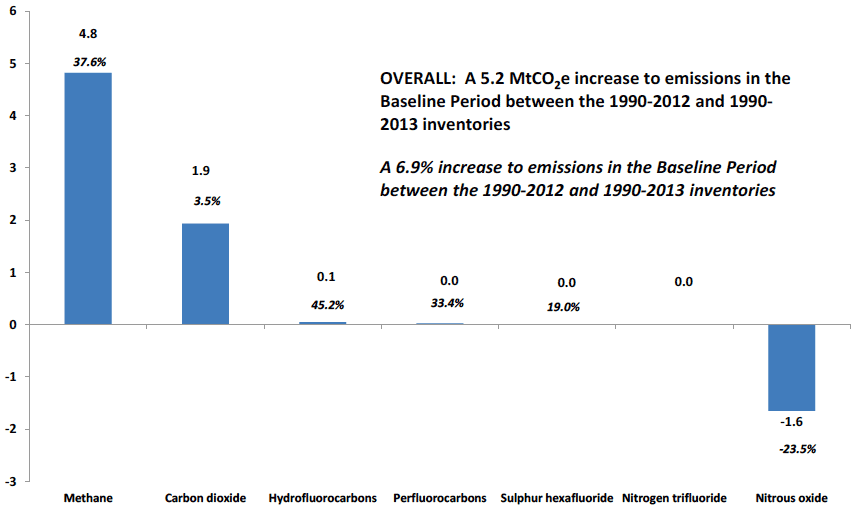
Chart D5. Revisions to 2012 emissions, from the 1990-2012 inventory to the 1990-2013 inventory, by greenhouse gas. Values in MtCO2e, and percentage changes
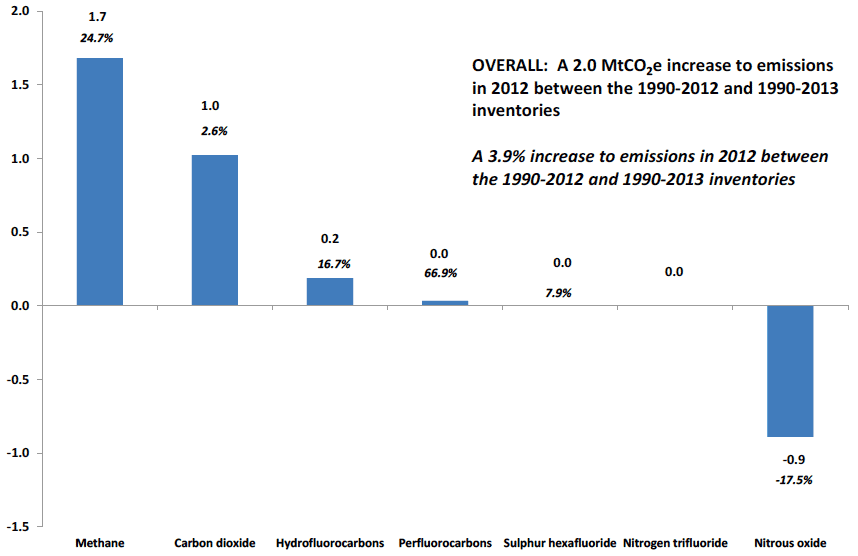
Table D1. Changes in emissions by source sector. Comparison of 1990-2012 and 1990-2013 inventories. Values in MtCO2e
| Baseline Period | 1990 | 2012 | 2013 | % change between Baseline Period and 2012 |
% change between 1990 and 2012 |
% change between Baseline Period and 2013 |
% change between 1990 and 2013 |
|
|---|---|---|---|---|---|---|---|---|
| Total | ||||||||
| 1990-2012 | 75.6 | 75.5 | 52.9 | -30.0% | -29.9% | |||
| 1990-2013 | 80.8 | 80.7 | 54.9 | 53.0 | -32.0% | -31.9% | -34.4% | -34.3% |
| Difference between 1990-2012 and 1990-2013 | 5.2 | 5.2 | 2.0 | |||||
| Energy Supply | ||||||||
| 1990-2012 | 22.4 | 22.4 | 17.1 | -23.5% | -23.5% | |||
| 1990-2013 | 22.7 | 22.7 | 17.5 | 16.0 | -23.0% | -23.0% | -29.5% | -29.5% |
| Difference between 1990-2012 and 1990-2013 | 0.3 | 0.3 | 0.4 | |||||
| Transport (including International Aviation and Shipping) | ||||||||
| 1990-2012 | 13.1 | 13.1 | 12.9 | -1.2% | -1.2% | |||
| 1990-2013 | 13.2 | 13.2 | 13.0 | 12.9 | -1.4% | -1.4% | -2.1% | -2.1% |
| Difference between 1990-2012 and 1990-2013 | 0.1 | 0.1 | 0.1 | |||||
| Transport (excluding IA&S) | ||||||||
| 1990-2012 | 10.5 | 10.5 | 10.5 | 0.1% | 0.1% | |||
| 1990-2013 | 10.6 | 10.6 | 10.6 | 10.5 | -0.2% | -0.2% | -1.0% | -1.0% |
| Difference between 1990-2012 and 1990-2013 | 0.1 | 0.1 | 0.1 | |||||
| International Aviation and Shipping (IA&S) | ||||||||
| 1990-2012 | 2.5 | 2.5 | 2.4 | -6.4% | -6.4% | |||
| 1990-2013 | 2.6 | 2.6 | 2.4 | 2.4 | -6.6% | -6.6% | -6.4% | -6.4% |
| Difference between 1990-2012 and 1990-2013 | 0.0 | 0.0 | 0.0 | |||||
| Agriculture and Related Land Use | ||||||||
| 1990-2012 | 15.2 | 15.2 | 11.2 | -26.7% | -26.7% | |||
| 1990-2013 | 16.1 | 16.1 | 12.5 | 12.4 | -22.2% | -22.2% | -23.1% | -23.1% |
| Difference between 1990-2012 and 1990-2013 | 0.9 | 0.9 | 1.4 | |||||
| Business and Industrial Process | ||||||||
| 1990-2012 | 13.6 | 13.5 | 8.5 | -37.3% | -37.0% | |||
| 1990-2013 | 14.4 | 14.3 | 8.9 | 9.1 | -38.2% | -37.9% | -36.6% | -36.3% |
| Difference between 1990-2012 and 1990-2013 | 0.8 | 0.8 | 0.3 | |||||
| Residential | ||||||||
| 1990-2012 | 8.2 | 8.2 | 7.3 | -11.1% | -10.8% | |||
| 1990-2013 | 8.0 | 8.0 | 7.0 | 7.0 | -13.0% | -12.3% | -13.0% | -12.4% |
| Difference between 1990-2012 and 1990-2013 | -0.1 | -0.2 | -0.3 | |||||
| Waste Management | ||||||||
| 1990-2012 | 6.7 | 6.7 | 2.8 | -58.6% | -58.6% | |||
| 1990-2013 | 9.9 | 9.9 | 3.2 | 2.7 | -67.5% | -67.5% | -72.6% | -72.6% |
| Difference between 1990-2012 and 1990-2013 | 3.2 | 3.2 | 0.4 | |||||
| Development | ||||||||
| 1990-2012 | 1.7 | 1.7 | 1.7 | -3.4% | -3.4% | |||
| 1990-2013 | 1.8 | 1.8 | 1.6 | 1.6 | -14.1% | -14.1% | -14.7% | -14.7% |
| Difference between 1990-2012 and 1990-2013 | 0.1 | 0.1 | -0.1 | |||||
| Public Sector Buildings | ||||||||
| 1990-2012 | 1.7 | 1.7 | 1.4 | -17.8% | -17.8% | |||
| 1990-2013 | 1.7 | 1.7 | 1.2 | 1.2 | -26.4% | -26.4% | -26.2% | -26.2% |
| Difference between 1990-2012 and 1990-2013 | 0.0 | 0.0 | -0.1 | |||||
| Forestry | ||||||||
| 1990-2012 | -7.0 | -7.0 | -9.9 | 41.9% | 41.9% | |||
| 1990-2013 | -7.0 | -7.0 | -10.0 | -10.0 | 42.1% | 42.1% | 42.0% | 42.0% |
| Difference between 1990-2012 and 1990-2013 | 0.0 | 0.0 | -0.1 | |||||
Details of Main Revisions
A complete list of the revisions between the previous and latest inventories can be found in the National Atmospheric Emissions Inventory report Greenhouse Gas Inventories for England, Scotland, Wales and Northern Ireland: 1990 - 2013[15]. Details of the most notable revisions are listed below:
1. Implementation of IPCC (2006) Guidelines
The UK and the Scottish greenhouse gas inventory are required to comply with reporting guidelines as prescribed by the IPCC. These guidelines have been updated for this year's release to reflect the details published in the IPCC's 4th Assessment Report[16]. The latest set of guidelines are known as the IPCC (2006) guidelines. These have been agreed internationally and replace the previous guidelines, which were referred to as the IPCC (1996) guidelines. The adoption of the IPCC (2006) guidelines has led to a number of revisions, as detailed below:
Revised Global Warming Potentials of greenhouse gases
The global warming potentials (GWPs) used for each gas have been updated to those published in the IPCC's 4th Assessment Report. Table D2 shows the revised GWPs as used in this year's publication, compared with those used in last year's publication. The impact of the GWP changes has been greatest on the agriculture and related land use and on the waste management sectors.
Table D2. Comparison of global warming potentials (GWP) of greenhouse gases, 1990-2012 and 1990-2013 inventories
| Name of Greenhouse Gas | Chemical Formula | 1990-2012 | 1990-2013 |
|---|---|---|---|
| Carbon dioxide | CO2 | 1 | 1 |
| Methane | CH4 | 21 | 25 |
| Nitrous oxide | N2O | 310 | 298 |
| F-gases | |||
| - Hydrofluorocarbons | HFC | 140 - 11,700 | 12 - 14,800 |
| - Perfluorocarbons | PFC | 6,500 - 9,200 | 7,390 - 17,340 |
| - Sulphur hexafluoride | SF6 | 23,900 | 22,800 |
| - Nitrogen trifluoride | NF3 | Not included | 17,200 |
New data sources and methodologies
New sources include the use of nitrous oxide in anaesthesia and emissions from composting. Some existing sources have also been updated with new methodologies, such as in the emissions of F gases in the Business and Industrial Process sector.
New greenhouse gas
A new F-gas, nitrogen trifluoride (NF3) has been included in the 1990-2013 inventory for the first time. This gas is only emitted in tiny amounts in Scotland and is emitted in the semiconductor industry.
2. Waste Management
Impact of IPCC (2006) guidelines
The majority of greenhouse gas emissions in the Waste Management sector are of methane. Changing the global warming potential of methane from 21 to 25 has resulted in emissions in the Baseline Period for this sector being revised upwards by around 1.2 MtCO2e and 2012 emissions being revised upwards by around 0.5 MtCO2e in 2012. There have also been new requirements under the IPCC (2006) guidelines to report on new sources for this first time - such as emissions from composting.
Landfill gas data
New information has been used for this publication from the Scottish Environment Protection Agency on the volumes of landfill gas flared and recovered at landfill sites; previously these volumes had been estimated. This has led to a downwards revision to emissions in recent years.
Waste decay data
New research from Defra has shown that the rate at which degradable waste is estimated to decay over time in landfill is slightly higher than previously thought. This increases methane emissions in the early part of the time series and decreases them after 2009.
Other changes
There have been further, more minor updates to emissions in this sector. These include:
- Changes to assumptions of gas combustion engine efficiency
- New data on waste composition.
- Revisions to estimates of industrial and domestic waste water treatment methods (to be consistent with IPCC (2006) guidelines)
- New emissions from private sewage treatment works
3. Agriculture and Related Land Use
Impact of IPCC (2006) guidelines
A considerable proportion of net greenhouse gas emissions in the Agriculture and Related Land Use sector are of methane and nitrous oxide. Changing the global warming potential of methane from 21 to 25 and changing that of nitrous oxide from 310 to 298 has resulted in emissions in the Baseline Period for this sector being revised upwards by around 0.6 MtCO2e and the 2012 emissions being revised upwards by around 0.5 MtCO2e.
Adopting the IPCC (2006) guidelines has also meant that there have been changes to the assumptions for the emissions from animal digestion (enteric fermentation), which have increased emissions across the series.
Implementing the IPCC (2006) guidelines has also meant that emissions for agricultural soils have been revised downwards, but not to the same extent as the upwards revisions in other parts of the Agricultural and Related Land Use source sector. This downward revision has been due to changes in emissions factors for agricultural soils. There have also been changes to assumptions regarding the greenhouse gas emissions from manure management practices in farms, which results in a small drop in emissions across the time series.
Drainage of Cropland and Grassland
DEFRA have published revised UK land areas of cropland and improved grassland on organic soils which have been drained for agricultural purposes. UNFCCC reviewers have requested for this information to be included in the inventory and they only relate to the drainage of these land use types. This has resulted in an increase in around 1.17 MtCO2e across the time series and they particularly affect the size of carbon sink from grasslands.
Cattle Weights
New research from DEFRA has resulted in updated estimates of the average weights of dairy cattle and beef cattle. This has led to further upwards revisions to enteric fermentation emissions by cattle across the time series
4. Business and Industrial Process
Chemical Industry
There has been a revision to emissions from petroleum fuels which are regarded as non-energy use due to their use in petrochemical manufacture. This has led to an increase in emissions in all years. There has also been incorporation of Phase III EU ETS data which has resulted in improvements in the completeness and allocation of the inventory for chemical sites.
5. Energy Supply
Changes to Allocations of Fuel Use
Some allocations of fuel use have been changed in DECC's Digest of UK Energy Statistics (DUKES). This has increased emissions as more fuel use has been allocated to activities which combust the fuel, and therefore release emissions. There has been a slight reallocation of emissions across the UK's power stations, to be consistent with the DUKES fuel use data. This has led to a slight increase in energy supply emissions in Scotland.
Revisions to Emission Factors For Some Fuels
Emission factors for coal, anthracite and coke have been updated to the IPCC default values as a result of questions received during the international review process. This has increased emissions by a small amount.
Fugitive Emissions
Emissions from fugitive emissions from gas and oil extraction in the UK have been revised to account for venting from the gas distribution network and there are now better estimates of emissions from small coal mines.
Cumulative revisions since 1990-2008
Revisions since the 1990-2008 inventory give a flavour of the scale of total revisions since the establishment of fixed annual Climate Change targets. Chart D6 shows that between the 1990-2008 inventory and the latest inventory, the average yearly increase in emissions in the Baseline Period has been 2.1 MtCO2e.
Chart D6. Revisions to emissions in the Baseline Period, from the 1990-2008 Inventory, to the Latest Inventory. Impact of Successive Revisions. Values in MtCO2e
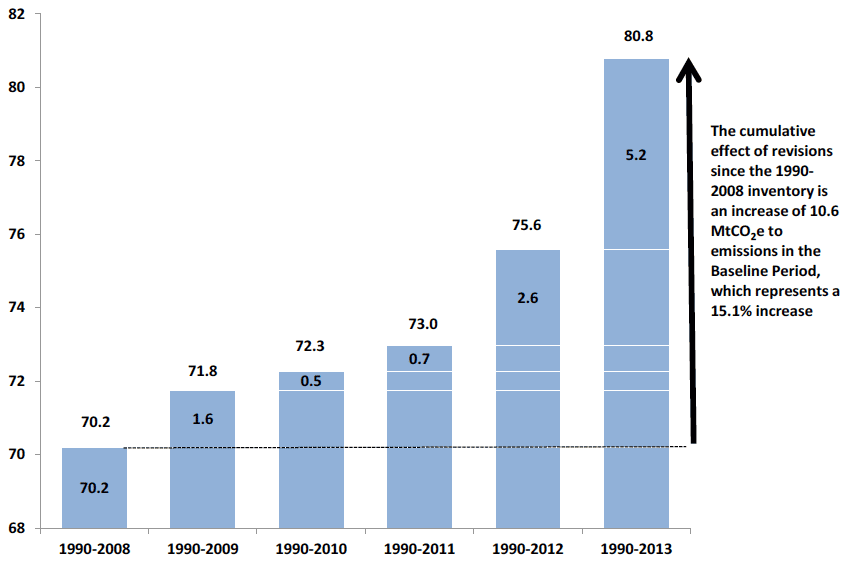
Interpretation of revisions to the inventory
The latest published Scotland greenhouse gas inventory (currently 1990-2013) represents the best available data at the time and these supersede any previous data, which should be disregarded. Very few revisions to the Greenhouse Gas Inventories arise as a result of 'errors' in the popular sense of the word. In fact, the compilation of the inventory is governed by a rigorous quality assurance process and is subject to a great deal of third party scrutiny, particularly by the UNFCCC at a UK level.
Interpretation of uncertainties in the inventory
All estimates, by definition, are subject to a degree of statistical 'error' but in this context it relates to the uncertainty inherent in any process or calculation that uses sampling, estimation or modelling.
Estimates of greenhouse gases are compiled by a consortium of contractors. The source emissions are based upon a range of data sources, ranging from model based estimates to point source emission data. As a result, the estimates are subject to a degree of uncertainty. Full analyses of these uncertainties are provided on the National Atmospheric Emissions Inventory website.
The Scottish Government has commissioned research to overhaul and update the uncertainties model used for the Scottish greenhouse gas inventory. A detailed study has been carried out in parallel with the compilation of the Scottish greenhouse gas inventory to review and improve the uncertainty calculations and can be found on the Scottish Government website.
Future revisions to the inventory
Every year, the greenhouse gas inventories are updated to reflect improvements in the underpinning science, data and modelling which often result in revisions to the entire time series. These revisions also reflect changes to the Intergovernmental Panel on Climate Change (IPCC) guidelines. The Scottish Government is represented at the UK's National Inventory Steering Committee, in which improvements to the Scottish and UK inventories are discussed. Some of the changes for the 1990-2014 inventory and for subsequent inventories are already known and overall, these are likely to increase Scotland's net emissions further.
There are a number of projects underway which might result in considerable upwards revisions for future inventories in a number of sectors. For instance:
- There is a project underway to better understand the behaviour of drained organic soils and the impact of this on how forests release or sequester carbon. This may considerably increase net emissions in this sector.
- An improved methodology is being developed to better represent emissions from land use changes
- There is a large scale, on-going programme of research to generate more detailed data on emissions in the agriculture sector.
- In the Waste Management sector, there is research underway to better understand the ratio of carbon dioxide to methane in landfill gas. This could considerably increase methane emissions in this sector.
- There is also likely to be a review of shipping emissions and of some carbon factors in the energy supply sector.
Note that there are likely to be further revisions in the 1990-2014 inventory which have not been noted within this publication.
Contact
Email: Martin Macfie
There is a problem
Thanks for your feedback